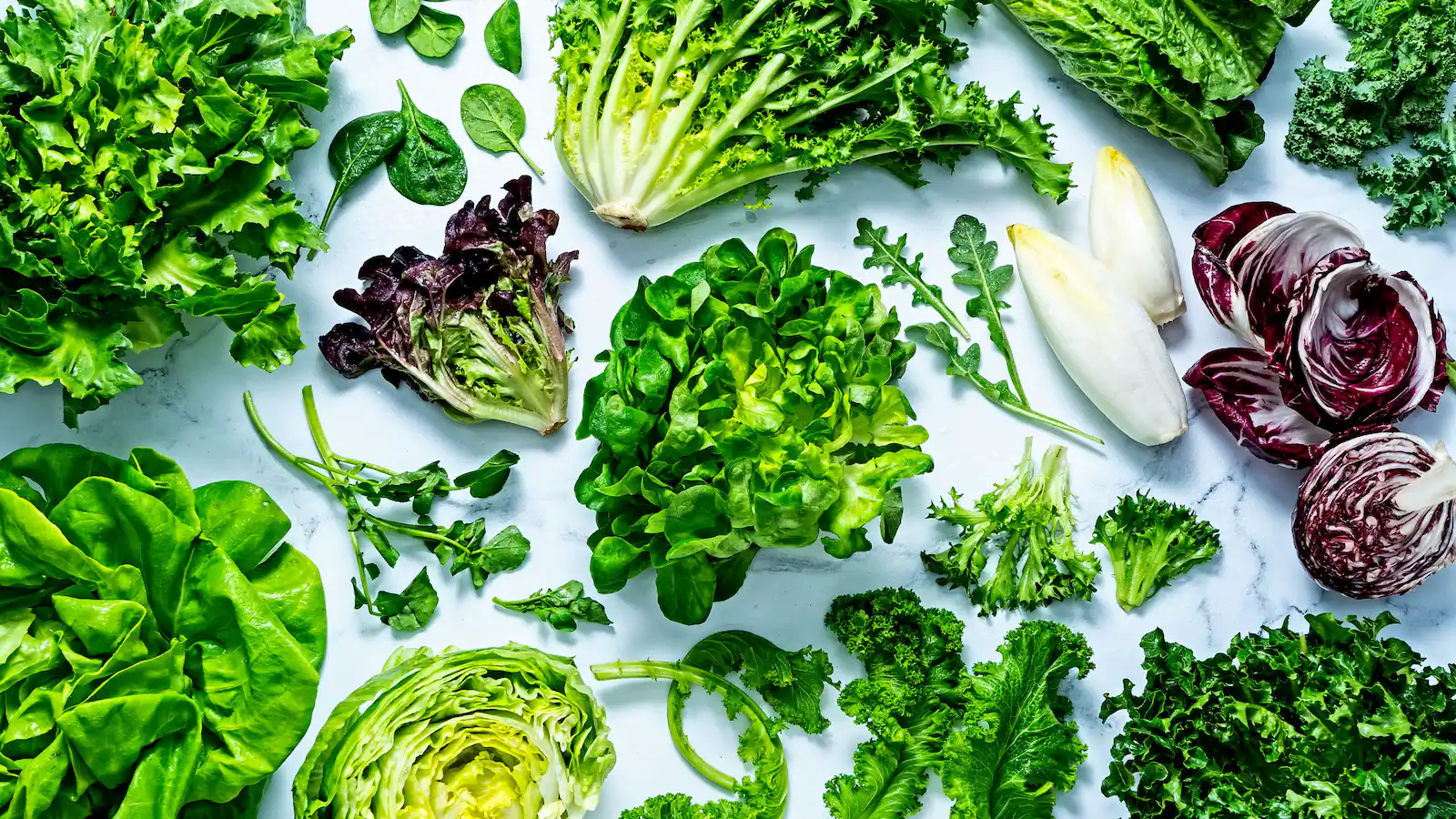
Leafy greens are nutritional powerhouses, offering a wealth of vitamins, minerals, and antioxidants that benefit your entire body. From heart health and glowing skin to improved digestion and stronger bones, these versatile vegetables are essential for a balanced diet.
Their ability to enhance both physical and mental well-being makes leafy greens a dietary must-have. This article highlights 15 remarkable benefits that show why these greens deserve a place in your daily meals.
Nutritional Profile Of Leafy Greens
Leafy greens are some of the most nutrient-dense foods available, offering a remarkable combination of essential vitamins, minerals, antioxidants, and fiber. Despite being low in calories, they pack a powerful punch of nutrients that contribute to overall health and wellness. Their versatility and accessibility make them a dietary staple across the globe. For an exciting twist, you can air-fry veggies for crunch, turning greens like kale into crispy, flavorful chips that make a healthy and satisfying snack.
1. Rich In Essential Vitamins
Leafy greens are an excellent source of vitamins that support various bodily functions:
- Vitamin A: Found in the form of beta-carotene, vitamin A supports vision, immune function, and skin health. Kale and spinach are particularly high in this vital nutrient.
- Vitamin C: This potent antioxidant strengthens the immune system, aids in collagen production, and fights oxidative stress. Swiss chard and mustard greens are among the top sources.
- Vitamin K: Essential for blood clotting and bone health, vitamin K is abundant in greens like collard greens, kale, and spinach. A single serving often exceeds the daily recommended intake.
2. High In Key Minerals
Leafy greens provide a wealth of minerals that are crucial for maintaining health:
- Iron: Necessary for oxygen transport in the blood, iron-rich greens like spinach and Swiss chard are especially beneficial for individuals prone to anemia.
- Calcium: Important for bone and teeth health, greens like collard greens and turnip greens are excellent plant-based sources of calcium.
- Magnesium: This mineral plays a key role in muscle and nerve function, as well as energy production. Kale and arugula are good sources of magnesium.
- Potassium: Found in abundance in greens like spinach and romaine lettuce, potassium helps regulate blood pressure and supports heart health.
3. Abundant In Fiber
Leafy greens are rich in both soluble and insoluble fiber, making them essential for digestive health. Fiber promotes regular bowel movements, feeds healthy gut bacteria, and helps maintain stable blood sugar levels. Greens like romaine lettuce and kale are particularly effective in supporting a healthy gut and preventing constipation.
4. Packed With Antioxidants And Phytonutrients
Leafy greens are loaded with antioxidants and phytonutrients that combat oxidative stress and inflammation:
- Lutein and Zeaxanthin: These carotenoids are known to support eye health by protecting against macular degeneration and harmful blue light.
- Chlorophyll: Found in deep green leaves, chlorophyll aids in detoxification by binding to toxins and heavy metals in the body.
- Flavonoids: These compounds reduce inflammation and lower the risk of chronic diseases such as heart disease and diabetes.
5. Low In Calories But High In Nutrient Density
Leafy greens are the epitome of nutrient density, providing maximum nutrition with minimal calories. For instance, a cup of raw spinach contains just 7 calories but delivers significant amounts of vitamins A and K, along with iron and magnesium. This makes them ideal for weight management and overall health.
6. Hydration Support
Many leafy greens, such as romaine lettuce and spinach, have high water content, contributing to hydration. Staying hydrated is essential for maintaining energy levels, supporting digestion, and promoting healthy skin.
1. Boost Heart Health
Leafy greens play a significant role in supporting cardiovascular health. Rich in potassium and magnesium, they help regulate blood pressure by counteracting the effects of sodium. Their high levels of folate lower homocysteine levels, a compound linked to heart disease.
Additionally, leafy greens are loaded with dietary nitrates, which improve blood flow and enhance arterial flexibility. By including greens like spinach, kale, and arugula in your diet, you reduce the risk of heart-related conditions like hypertension and stroke.
2. Support Digestive Health
Leafy greens are a powerhouse of dietary fiber, a key component for digestive health. Fiber aids in maintaining regular bowel movements and preventing constipation. It also fosters the growth of healthy gut bacteria, improving overall gut health and nutrient absorption.
Greens like Swiss chard and romaine lettuce are particularly effective in promoting a healthy digestive system. The natural water content in many leafy greens adds hydration to the digestive tract, making them a perfect food for those seeking to improve gut function.
3. Promote Healthy Skin
The antioxidants found in leafy greens, such as vitamin C and beta-carotene, are essential for skin health. Vitamin C stimulates collagen production, which keeps skin firm and reduces the appearance of wrinkles.
Beta-carotene, a precursor to vitamin A, helps repair skin damage and protects against harmful UV rays. Furthermore, greens like spinach and kale are rich in zinc, which reduces inflammation and supports clear, hydrated skin. Incorporating these greens into your diet results in a glowing, youthful complexion.
4. Strengthen Bones
Leafy greens are an excellent source of calcium, magnesium, and vitamin K, all of which are vital for bone health. Vitamin K enhances calcium absorption and improves bone density, reducing the risk of fractures and osteoporosis.
Magnesium works alongside calcium to maintain bone structure and strength. Dark, leafy vegetables such as collard greens and turnip greens provide a natural, plant-based source of these essential nutrients, making them a cornerstone of a bone-strengthening diet.
5. Aid Weight Management
Low in calories but high in volume, leafy greens are perfect for those looking to manage their weight. The high fiber content promotes a feeling of fullness, reducing the likelihood of overeating. Greens like spinach and arugula are nutrient-dense, meaning they provide a wealth of vitamins and minerals without adding extra calories.
Their natural compounds may also boost metabolism, helping the body burn calories more efficiently. By replacing calorie-dense foods with leafy greens, you can maintain a healthy weight while staying nourished.
6. Improve Eye Health
Leafy greens are rich in lutein and zeaxanthin, two powerful antioxidants that protect the eyes from harmful light and reduce the risk of macular degeneration and cataracts. These compounds filter harmful blue light, protecting the retina and maintaining long-term vision health.
Vitamin A in greens like kale and collard greens also contributes to better night vision. Regular consumption of leafy greens is an easy and effective way to support your eyesight and prevent age-related eye conditions.
7. Reduce Inflammation
Inflammation is a root cause of many chronic diseases, and leafy greens are known for their anti-inflammatory properties. Compounds like flavonoids, carotenoids, and omega-3 fatty acids found in greens combat inflammation at a cellular level.
Kale, spinach, and arugula are particularly effective in reducing markers of inflammation, providing relief for conditions such as arthritis, autoimmune disorders, and even muscle soreness after exercise. A diet rich in leafy greens helps manage inflammation and promotes overall well-being.
8. Enhance Immune Function
Leafy greens are loaded with immune-boosting nutrients like vitamins C and A, folate, and zinc. These nutrients strengthen the immune system, helping the body fight off infections and recover more quickly from illnesses.
Vitamin C in greens like spinach increases the production of white blood cells, which are crucial for defending the body against pathogens. Additionally, the antioxidants in greens neutralize free radicals, reducing oxidative stress and further supporting immune health.
9. Help Prevent Chronic Diseases
The phytonutrients and antioxidants in leafy greens act as protective compounds that reduce the risk of chronic diseases. These compounds work to neutralize free radicals, which can cause cellular damage and lead to conditions such as cancer, diabetes, and cardiovascular diseases.
Greens like broccoli leaves and mustard greens contain glucosinolates, which have been shown to lower the risk of certain cancers. Incorporating a variety of leafy greens into your diet is a proactive way to protect your body from long-term health issues.
10. Support Mental Health
Leafy greens contribute significantly to mental health, thanks to their high levels of folate and antioxidants. Folate plays a key role in the production of neurotransmitters like serotonin, which regulate mood and reduce the risk of depression.
Additionally, the anti-inflammatory properties of leafy greens protect the brain from cognitive decline and disorders like Alzheimer’s disease. Regular consumption of greens like spinach and Swiss chard promotes mental clarity and emotional well-being.
11. Boost Energy Levels
Iron and magnesium in leafy greens are essential for energy production in the body. Iron helps transport oxygen to cells, reducing fatigue and improving stamina, while magnesium supports muscle function and energy metabolism.
Greens like spinach and kale are particularly beneficial for individuals with low iron levels, including those with anemia. By including leafy greens in your meals, you can maintain higher energy levels throughout the day.
12. Detoxify The Body
Leafy greens, especially those high in chlorophyll like kale and wheatgrass, aid in the detoxification process. Chlorophyll binds to toxins and heavy metals in the body, helping to eliminate them through the digestive system.
Additionally, the high fiber content of leafy greens supports liver health by promoting the removal of waste products. Adding greens to smoothies, salads, or soups is a simple way to support the body’s natural detoxification process.
13. Support Healthy Pregnancy
Leafy greens are an essential food for expectant mothers due to their high levels of folate, a nutrient critical for fetal development. Folate prevents neural tube defects and supports the formation of red blood cells.
Greens like spinach and kale also provide iron and calcium, which are crucial for the health of both mother and baby. Including leafy greens in a prenatal diet ensures that both nutritional needs are met.
14. Balance Blood Sugar Levels
Leafy greens are low on the glycemic index, meaning they have little to no effect on blood sugar levels. The fiber in greens slows down sugar absorption, preventing blood sugar spikes and crashes.
This makes them an excellent food choice for individuals with diabetes or insulin resistance. Swiss chard and collard greens contain compounds that enhance insulin sensitivity, further aiding in blood sugar management.
15. Improve Hair Health
The nutrients in leafy greens, including biotin, iron, and vitamin A, are essential for healthy hair growth. Biotin strengthens hair follicles, while iron prevents hair loss by improving circulation to the scalp.
Vitamin A helps produce sebum, a natural oil that keeps the scalp moisturized and prevents dryness. Regular consumption of spinach, kale, and other greens results in shinier, healthier hair.
Tips For Adding More Leafy Greens To Your Diet
1. Start Your Day With Greens
One of the easiest ways to add leafy greens to your diet is by incorporating them into your breakfast. Add a handful of spinach or kale to your morning smoothie for a nutrient boost without compromising flavor. Alternatively, mix greens into your scrambled eggs or omelets to create a wholesome, fiber-rich start to the day.
2. Upgrade Your Salads
Transform your salads from boring to exciting by using a mix of leafy greens like arugula, kale, romaine, and Swiss chard as the base. Top them with colorful vegetables, nuts, seeds, and a protein source like grilled chicken or tofu. Experiment with dressings that complement the greens, such as balsamic vinaigrette or a tahini-based dressing, to enhance their flavor.
3. Add Greens To Soups And Stews
Leafy greens like spinach, kale, and collard greens blend seamlessly into soups and stews. They add a hearty texture and boost the nutrient content of the dish. Simply stir them in during the final minutes of cooking to preserve their bright color and nutritional value.
4. Blend Them Into Smoothies
For a refreshing and nutrient-packed drink, add a handful of leafy greens to your favorite fruit smoothie. Spinach works particularly well due to its mild flavor, blending effortlessly with ingredients like bananas, berries, and almond milk. This is an excellent way to incorporate greens without even tasting them.
5. Use Greens As Wraps Or Shells
Swap out traditional wraps or tortillas with large leafy greens like collard greens, Swiss chard, or romaine lettuce. These greens make excellent low-carb, nutrient-dense alternatives for wraps, tacos, or spring rolls. Fill them with your favorite ingredients for a healthy, portable meal option.
6. Sneak Greens Into Sauces And Pestos
Blend leafy greens like spinach, arugula, or basil into sauces or pestos for a flavor and nutrition boost. For example, add spinach to marinara sauce or use kale as the base for a vibrant, homemade pesto. These sauces can be used on pasta, pizza, or as a dip for vegetables.
7. Top Your Pizzas And Flatbreads
Leafy greens make a delicious topping for pizzas and flatbreads. Add arugula or spinach after baking for a fresh, peppery crunch, or mix them into the cheese layer before baking for a warm, wilted texture. This is a fun and tasty way to include greens in a family-friendly meal.
8. Try Sautéed Greens As A Side Dish
Sautéed greensare a quick and simple way to enjoy leafy vegetables. Heat olive oil or butter in a pan, add garlic or onions, and toss in greens like spinach, kale, or Swiss chard. Season with salt, pepper, and a squeeze of lemon for a flavorful side dish that pairs well with any main course.
9. Boost Grain Bowls And Stir-Fries
Add a handful of greens to grain bowls or stir-fries for extra nutrients and texture. Toss spinach or kale into warm quinoa bowls or mix bok choy and arugula into stir-fried vegetables. The heat from the grains or stir-fry lightly wilts the greens, making them tender and flavorful. For a healthier cooking alternative, you can also grill veggies without oil, which enhances their natural flavors while keeping the dish light and nutritious.
10. Bake Them Into Chips
Transform kale, spinach, or Swiss chard into crispy, flavorful chips by baking them. Simply toss the greens with olive oil, season with your favorite spices, and bake at a low temperature until crisp. These chips make a nutritious and satisfying snack alternative to store-bought options.
11. Store Greens Properly To Keep Them Fresh
To ensure your greens stay fresh and ready to use, store them correctly. Wrap them in a damp paper towel and place them in a breathable bag in the refrigerator. This helps maintain their crispness and extends their shelf life, encouraging you to incorporate them into more meals.
FAQs
Which Leafy Greens Are The Most Nutritious?
Dark, leafy greens like kale, spinach, Swiss chard, and collard greens are among the most nutrient-dense. They contain higher amounts of vitamins, minerals, and antioxidants compared to lighter greens like iceberg lettuce. Each type offers unique benefits, so incorporating a variety is ideal.
How Many Servings Of Leafy Greens Should I Eat Daily?
Experts recommend eating at least 2–3 cups of leafy greens daily. This can be achieved by adding them to salads, smoothies, soups, or as side dishes. Including greens in multiple meals throughout the day makes it easy to meet this goal.
Can Leafy Greens Help With Weight Loss?
Yes, leafy greens are low in calories and high in fiber, which promotes satiety and reduces overeating. Their nutrient density ensures you get essential vitamins and minerals while maintaining a calorie deficit, making them excellent for weight management.
Are Raw Or Cooked Leafy Greens Healthier?
Both raw and cooked greens have unique benefits. Cooking certain greens, like spinach and kale, can enhance nutrient absorption (e.g., calcium and iron), while raw greens retain vitamin C and some antioxidants. A mix of both raw and cooked greens provides the best balance of nutrients.
Can Eating Leafy Greens Improve Digestion?
Yes, the high fiber content in leafy greens supports healthy digestion by promoting regular bowel movements and feeding beneficial gut bacteria. They also reduce bloating and help prevent constipation.
Conclusion
Leafy greens are more than just healthy; they’re transformative. With benefits like improved digestion, better heart health, and radiant skin, they’re essential for a vibrant lifestyle.
Adding these superfoods to your diet is a simple step toward better health. Start incorporating them into your meals today and enjoy their incredible impact on your well-being.

